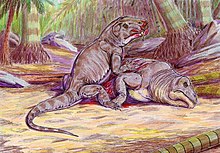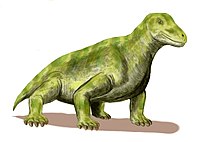| This article needs additional citations for verification. Please help improve this article by adding citations to reliable sources. Unsourced material may be challenged and removed. Find sources: "Dinocephalia" – news · newspapers · books · scholar · JSTOR (August 2024) (Learn how and when to remove this message) |
| Dinocephalia Temporal range: Early - Middle Permian, 279.5–260 Ma PreꞒ Ꞓ O S D C P T J K Pg N | |
|---|---|

| |
| Restoration of two genera of dinocephalians : Titanophoneus (an anteosaur) devouring a Ulemosaurus (a tapinocephalian). | |
| Scientific classification | |
| Domain: | Eukaryota |
| Kingdom: | Animalia |
| Phylum: | Chordata |
| Clade: | Synapsida |
| Clade: | Therapsida |
| Suborder: | †Dinocephalia Seeley, 1894 |
| Subgroups | |
|
See Taxonomy | |
Dinocephalians (terrible heads) are a clade of large-bodied early therapsids that flourished in the Early and Middle Permian between 279.5 and 260 million years ago (Ma), but became extinct during the Capitanian mass extinction event. Dinocephalians included herbivorous, carnivorous, and omnivorous forms. Many species had thickened skulls with many knobs and bony projections. Dinocephalians were the first non-mammalian therapsids to be scientifically described and their fossils are known from Russia, China, Brazil, South Africa, Zimbabwe, and Tanzania.
Description


Apart from the biarmosuchians, the dinocephalians are the least advanced therapsids, although still uniquely specialised in their own way. They retain a number of primitive characteristics (e.g. no secondary palate, small dentary) shared with their pelycosaur ancestors, although they are also more advanced in possessing therapsid adaptations like the expansion of the ilium and more erect limbs.
They include carnivorous, herbivorous, and omnivorous forms. Some, like Keratocephalus, Moschops, Struthiocephalus and Jonkeria were semiaquatic, others, like Anteosaurus, were more terrestrial.
Dinocephalians were among the largest animals of the Permian period; only the biggest caseids and pareiasaurs reaching them in size.
Size
Dinocephalians were generally large. The biggest herbivores (Tapinocephalus) and omnivores (Titanosuchus) may have weighed up to 2 tonnes (4,400 lb), and were some 4.5 metres (15 ft) long, while the largest carnivores (such as Titanophoneus and Anteosaurus) were at least as long, with heavy skulls 80 centimetres (31 in) long, and overall masses of around a half-tonne.
Skull
All dinocephalians are distinguished by the interlocking incisor (front) teeth. Correlated features are the distinctly downturned facial region, a deep temporal region, and forwardly rotated suspensorium. Shearing contact between the upper and lower teeth (allowing food to be more easily sliced into small bits for digestion) is achieved through keeping a fixed quadrate and a hinge-like movement at the jaw articulation. The lower teeth are inclined forward, and occlusion is achieved by the interlocking of the incisors. The later dinocephalians improved on this system by developing heels on the lingual sides of the incisor teeth that met against one another to form a crushing surface when the jaws were shut.
Most dinocephalians also developed pachyostosis of the bones in the skull, which seems to have been an adaptation for intra-specific behaviour (head-butting), perhaps for territory or a mate. In some types, such as Estemmenosuchus and Styracocephalus, there are also horn-like structures, which evolved independently in each case.
Evolutionary history
| ||||||||||||||||||||||||||||||||||||
| Phylogeny of Dinocephalia following Fraser-King et al. 2019 |
The dinocephalians are an ancient group and their ancestry is not clear. It is assumed that they must have evolved during the earlier part of the Roadian, or possibly even the Kungurian epoch, but no trace has been found. These animals radiated at the expense of the dying pelycosaurs, who dominated during the early part of the Permian and may have even gone extinct due to competition with therapsids, especially the short-lived but most dominant dinocephalians. Even the earliest members, the estemmenosuchids and early brithopodids of the Russian Ocher fauna, were already a diverse group of herbivores and carnivores.
During the Wordian and early Capitanian, advanced dinocephalians radiated into a large number of herbivorous forms, representing a diverse megafauna. This is well known from the Tapinocephalus Assemblage Zone of the Southern African Karoo.
At the height of their diversity (middle or late Capitanian age) all the dinocephalians suddenly died out, during the Capitanian mass extinction event. The reason for their extinction is not clear; although disease, sudden climatic change, or other factors of environmental stress may have brought about their end. They were replaced by much smaller therapsids; herbivorous dicynodonts and carnivorous biarmosuchians, gorgonopsians and therocephalians.
Taxonomy



- Class Synapsida
- Order Therapsida
- Suborder Dinocephalia
- ?Driveria
- ?Mastersonia
- Family Estemmenosuchidae
- ?Family Phreatosuchidae
- ?Family Phthinosuchidae
- Family Rhopalodontidae
- Clade Anteosauria
- Family Anteosauridae
- Family Brithopodidae
- Family Deuterosauridae
- Clade Tapinocephalia
- ?Dimacrodon
- ?Driveria
- ?Mastersonia
- Family Styracocephalidae
- Family Tapinocephalidae
- Family Titanosuchidae
- Suborder Dinocephalia
- Order Therapsida
See also
References
- Day, Michael O.; Guven, Saniye; Abdala, Fernando; Jirah, Sifelani; Rubidge, Bruce; Almond, John (2015). "Youngest dinocephalian fossils extend the Tapinocephalus Zone, Karoo Basin, South Africa". South African Journal of Science. 111: 1–5.
- "Driveria". Fossilworks.
- Nicolas, Merrill; Rubidge, Bruce S. (2010). "Changes in Permo-Triassic terrestrial tetrapod ecological representation in the Beaufort Group (Karoo Supergroup) of South Africa". Lethaia. 43: 45–59. doi:10.1111/j.1502-3931.2009.00171.x.
- Kammerer, Christian F. (13 December 2010). "Systematics of the Anteosauria (Therapsida: Dinocephalia)". Journal of Systematic Palaeontology. 9 (2): 261–304. doi:10.1080/14772019.2010.492645.
- Angielczyk, K.D. (2009). "Dimetrodon is not a dinosaur: Using tree thinking to understand the ancient relatives of mammals and their evolution". Evolution: Education and Outreach. 2 (2): 257–271. doi:10.1007/s12052-009-0117-4.
- Simon, Rachel V.; Sidor, Christian A.; Angielczyk, Kenneth D.; Smith, Roger M.H. (2010). "First record of a Tempinocephalid (Therapsida: Dinocephalia) from the Ruhuhu Formation (Songea Group) of Southern Tanzania". Journal of Vertebrate Paleontology. 30 (4): 1289–1293. doi:10.1080/02724634.2010.483549. S2CID 131447562.
- Mohd Shafi Bhat, Christen D. Shelton, Anusuya Chinsamy (2021). "Bone histology of dinocephalians (Therapsida, Dinocephalia): palaeobiological and palaeoecological inferences". Papers in Palaeontology. 8 (1). doi:10.1002/spp2.1411.
{{cite journal}}: CS1 maint: multiple names: authors list (link) - Fraser-King, Simon W.; Benoit, Julien; Day, Michael O.; Rubidge, Bruce S. (2019). "Cranial morphology and phylogenetic relationship of the enigmatic dinocephalian Styracocephalus platyrhynchus from the Karoo Supergroup, South Africa". Palaeontologia Africana. 54: 14–29.
Further reading
- Carroll, R.L. (1988). Vertebrate Paleontology and Evolution. W.H. Freeman.
External links
- "Dinocephalia". Palaeos.com.
- "Dinocephalia". Palaeocritti.com.
| Synapsida | |||||||||||||||||||||||||||||||||||
|---|---|---|---|---|---|---|---|---|---|---|---|---|---|---|---|---|---|---|---|---|---|---|---|---|---|---|---|---|---|---|---|---|---|---|---|
| |||||||||||||||||||||||||||||||||||
| |||||||||||||||||||||||||||||||||||
| |||||||||||||||||||||||||||||||||||
| |||||||||||||||||||||||||||||||||||
| |||||||||||||||||||||||||||||||||||
| Dinocephalia | ||||||||||||||||||||||||||||||||||||||
|---|---|---|---|---|---|---|---|---|---|---|---|---|---|---|---|---|---|---|---|---|---|---|---|---|---|---|---|---|---|---|---|---|---|---|---|---|---|---|
| ||||||||||||||||||||||||||||||||||||||
| ||||||||||||||||||||||||||||||||||||||
| Taxon identifiers | |
|---|---|
| Dinocephalia | |







